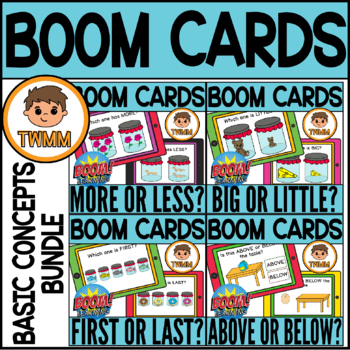Basic Concepts BUNDLE l Comparing Positions & Size l Math Boom Cards
- Zip
- Internet Activities
What educators are saying
Products in this Bundle (4)
Bonus
Description
This Boom Bundle contains 4 self-grading decks of 30 cards which are perfect for reinforcement of the basic mathematical concepts regarding comparing objects, position and size. The four decks included are "More or Less?", "First or Last?", "Big or Little?" and "Above or Below?". These can be used in early years (e.g Pre-K), speech therapy, special education or just to reinforce concepts.
There are 30 cards in each deck, however only 22 will be assigned each play at random to ensure each time they play it's a new game!
You will receive a PDF similar to the preview, however the paid version will include a hyperlinked image to download the full Boom product. Please use the "Bonus File" PDF to download this bundle.
Trial the Boom Cards here! You can play the first 4 cards of each deck to see if it's for you!
HOW TO USE THESE DIGITAL TASK CARDS:
Your students should use one of these ways to access Boom Learning:
1. https://boom.cards
2. A Boom Cards App (Apple store, Google Play, and Kindle Fire Store)
3. Scan a QR Code (generated from the classroom)
New to Boom Learning? Check out this video that explains all about using Boom Cards™.
Boom Cards™ can also be linked directly to your SeeSaw classroom! Check out this video that explains how to use Boom Cards™ with SeeSaw.
To use Boom Cards, you must be connected to the Internet. Boom Cards play on modern browsers (Chrome, Safari, Firefox, and Edge). Apps are available for Android, iPads, iPhones, and Kindle Fires. For security and privacy, adults must have a Boom Learning account to use and assign Boom Cards. You will be able to assign the Boom Cards you are buying with "Fast Pins," (play provides instant feedback for self-grading Boom Cards). Fast Play is always a free way for students to engage with Boom Cards decks. For additional assignment options you'll need a premium account. If you are new to Boom Learning, you will be offered a free trial of our premium account. Read here for details: http://bit.ly/BoomTrial.
Not sure if Boom Cards™ are right for you? Download the preview file to try out a deck!
Interested in creating your own Boom cards? Check out my Boom Backgrounds here to get you started!
Want free credits to use on your next purchase?
Remember: For every $1 you spend on TpT, you can earn 1 credit. Every 20 credits earned equals $1 you can apply to future TpT purchases. After purchasing this product, you must then review it to earn your credit.
Credits available for this product: 6
© Teaching with Mr McDonald 2020





